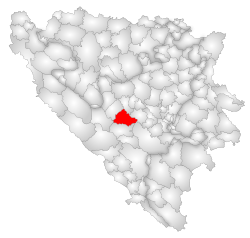Gornji Vakuf-Uskoplje
| Gornji Vakuf-Uskoplje Горњи Вакуф-Ускопље | |
|---|---|
| Municipality and town | |
 | |
 Location of Gornji Vakuf-Uskoplje within Bosnia and Herzegovina. | |
 Gornji Vakuf-Uskoplje Location of Gornji Vakuf - Uskoplje | |
| Coordinates: 43°56′N 17°35′E / 43.933°N 17.583°ECoordinates: 43°56′N 17°35′E / 43.933°N 17.583°E | |
| Country |
|
| Entity | Federation of Bosnia and Herzegovina |
| Government | |
| • Municipality president | Sead Čaušević (SDA) |
| Area | |
| • Total | 402 km2 (155 sq mi) |
| Population (2013 census) | |
| • Total | 22,304 |
| • Density | 55,5/km2 (1,440/sq mi) |
| Time zone | CET (UTC+1) |
| • Summer (DST) | CEST (UTC+2) |
| Area code(s) | +387 30 |
| Website |
gornjivakuf-uskoplje |
Gornji Vakuf-Uskoplje is a town and municipality in central Bosnia and Herzegovina, located between Bugojno, Prozor-Rama, Kupres, Novi Travnik and Konjic. It is under the administration of the Federation of Bosnia and Herzegovina
Name
Although settlement in the area stretches back to prehistoric times, the town with Gornji Vakuf name arose in the 16th century in the location of the existing settlement called Česta. The name Gornji Vakuf refers to the fact that the town was established as a waqf (Vakuf) by Bosniak nobility. Mehmed-beg Stočanin, a famous Bosniak bey, is the founder of Gornji Vakuf. This town has a typical Bosnian čaršija, which is common in Central Bosnia.
History
Bosnian War
Gornji Vakuf-Uskoplje was made infamous as one of the first towns to suffer from the Croat-Bosniak war (1992–94) during the Bosnian war (1992–95) - as a critical node - was vital for UNPROFOR to hold to enable UNHCR supplies to move into the country. It was held by B Company Group 1 CHESHIRE from the British Army during part of early 1993 who lost Lance corporal Wayne Edwards, who was shot by an unidentified sniper.[1]
Gornji Vakuf had a population of about 10,000 Croats and 14,000 Bosniaks. On 11 January 1993 the first clashes between the Croatian Defence Council (HVO) and the Army of the Republic of Bosnia and Herzegovina (ARBiH) took place. There are conflicting reports as to how the fighting started and what caused it; a bomb placed in a Muslim owned hotel used as a headquarters or an all-out attack by ARBiH forces on HVO positions.[2] The HVO had around 300 forces in the town and 2,000 in the surrounding area, while the ARBiH deployed several brigades of its 3rd Corps. A front line was established through the center of town. HVO artillery fired from positions on the hills to the southeast on ARBiH forces in Gornji Vakuf after their demands for surrender were rejected until a ceasefire was arranged.[3][4]
On 1 August 1993, the ARBiH launched an offensive on the HVO in Gornji Vakuf and won control over most of the town by the following day. The HVO retained control over a Croat neighborhood in the southwest and the ARBiH, lacking necessary reinforcements, couldn't continue its offensive. The name of the Croat-held part was later changed to Uskoplje. The HVO attempted a counterattack from its positions to the southwest of the town on 5 August, but the ARBiH was able to repel the attack. Another attack by the HVO started in September, reinforced with tanks and heavy artillery, but it was also unsuccessful.[5]
Settlements
• Batuša • Bistrica • Bojska • Boljkovac • Borova Ravan • Crkvice • Cvrče • Dobrošin • Donja Ričica • Dražev Dol • Duratbegov Dolac • Duša • Gaj • Galičica • Gornja Ričica • Gornji Mračaj • Gornji Vakuf • Grnica • Hrasnica • Humac • Jagnjid • Jelače • Jelići • Kozice • Krupa • Kute • Lužani • Mačkovac • Mračaj • Osredak • Pajić Polje • Paloč • Pidriš • Ploča • Podgrađe • Pridvorci • Rosulje • Seferovići • Seoci • Smrčevice • Svilići • Šugine Bare • Uzričje • Vaganjac • Valice • Vilić Polje • Voljevac • Voljice • Vrse • Zastinje • Ždrimci.
Demographics
1971
19,344 total
- Bosniaks - 10,482 (54.18%)
- Croats - 8,605 (44.48%)
- Serbs - 141 (0.72%)
- Yugoslavs - 18 (0.09%)
- others - 98 (0.53%)
1991
In the census of 1991, the municipality of Gornji Vakuf-Uskoplje had 25,130 inhabitants: 56.05% Bosniaks, 42.61% Croats, 0.60% Yugoslavs, 0.42% Serbs and 0.31% others.[6]
The town itself had 5,349 residents, of which 61% Bosniaks, 34% Croats, 2% Yugoslavs, 1% Serbs and 1% others.
| Ethnicity | Number | Percent (%) |
| Bosniaks | 14,063 | 55.84% |
| Croats | 10,706 | 42.51% |
| Yugoslavs | 158 | 0.62% |
| others | 144 | 0.60% |
| Serbs | 110 | 0.43% |
| TOTAL | 25,181 | 100% |
Notable persons
- Almir Pandzo, handball player
- Branko Mikulić, politician
- Matej Delač, football goalkeeper
- Nihad Alibegović, singer
References
- ↑ "Sniper 'not told to shoot UK soldier in Bosnia': First British soldier was unlawfully killed". The Independent. London, UK. 16 June 1993. Retrieved 26 September 2011.
- ↑ "ICTY: Kordić and Čerkez verdict - IV. Attacks on towns and villages: killings - 2. The Conflict in Gornji Vakuf" (PDF). pp. 179–181. Retrieved 23 November 2015.
- ↑ Central Intelligence Agency, Office of Russian and European Analysis (2002). Balkan Battlegrounds: A Military History of the Yugoslav Conflict, 1990–1995, Volume 1. Washington, D.C.: Central Intelligence Agency. pp. 190–191. ISBN 978-0-16-066472-4.
- ↑ Shrader, Charles R. (2003). The Muslim-Croat Civil War in Central Bosnia: A Military History, 1992–1994. College Station, Texas: Texas A&M University Press. pp. 74–75. ISBN 978-1-58544-261-4.
- ↑ Central Intelligence Agency, Office of Russian and European Analysis (2002). Balkan Battlegrounds: A Military History of the Yugoslav Conflict, 1990–1995, Volume 1. Washington, D.C.: Central Intelligence Agency. p. 199. ISBN 978-0-16-066472-4.
- ↑ Hdmagazine - Bosnian Census
| Wikimedia Commons has media related to Gornji Vakuf-Uskoplje. |